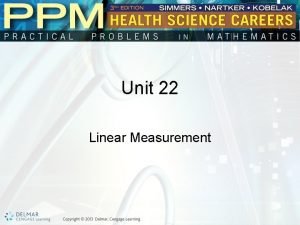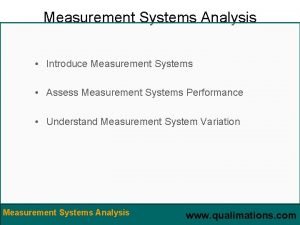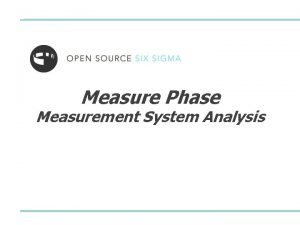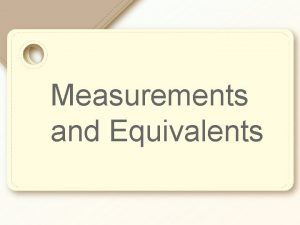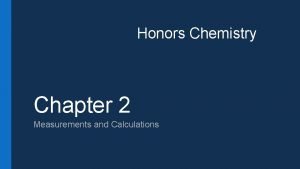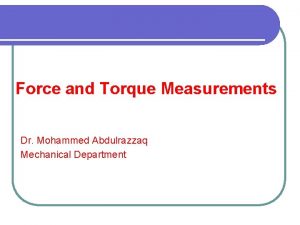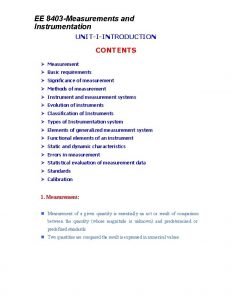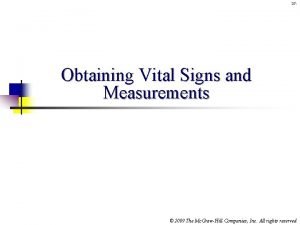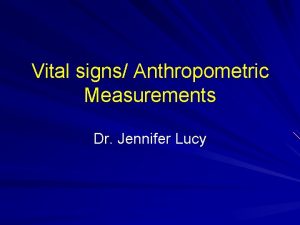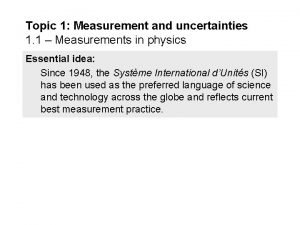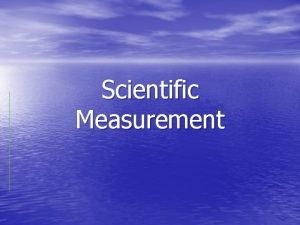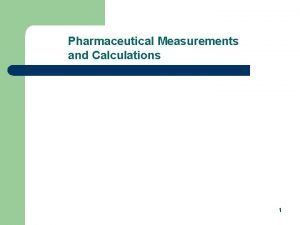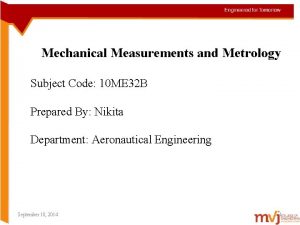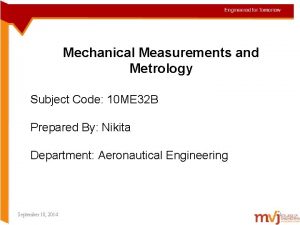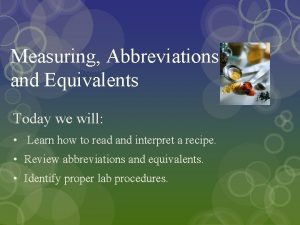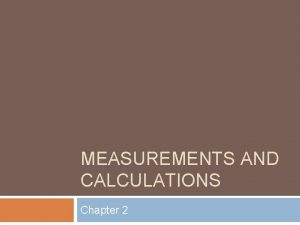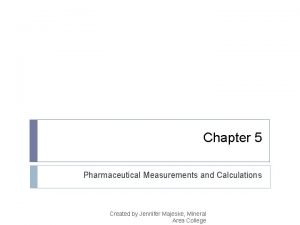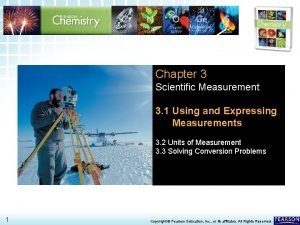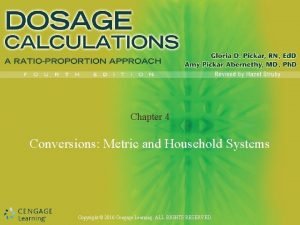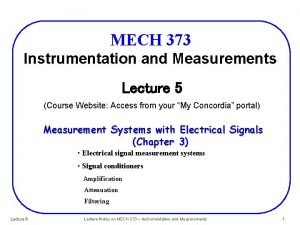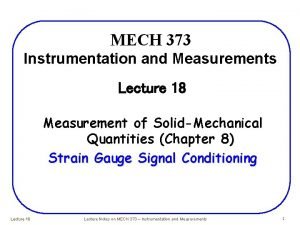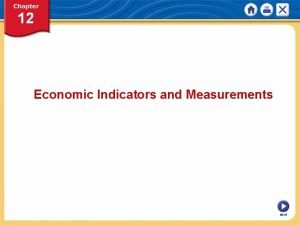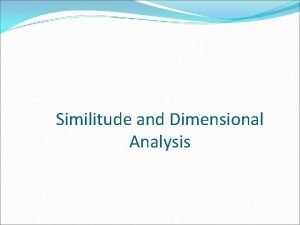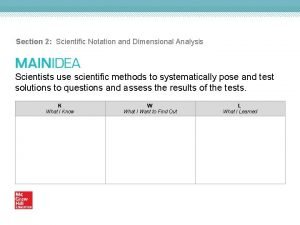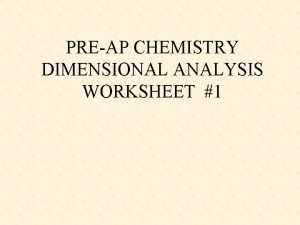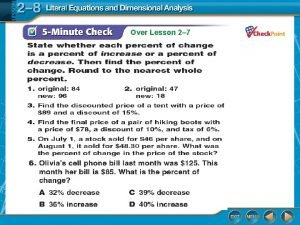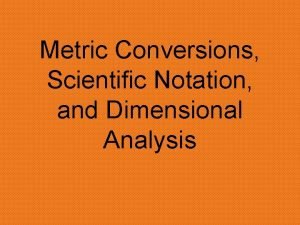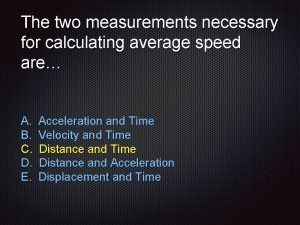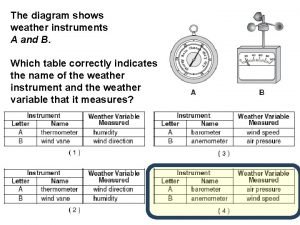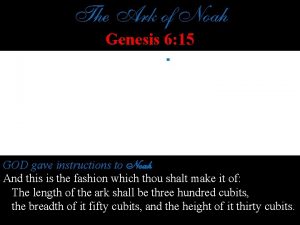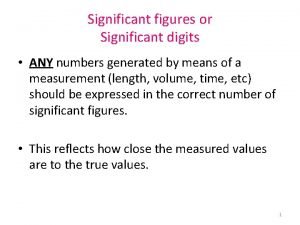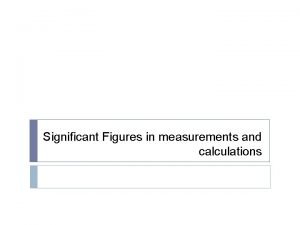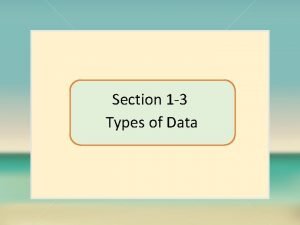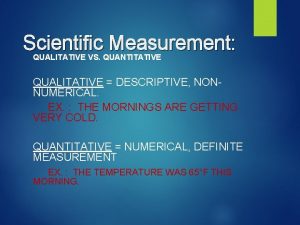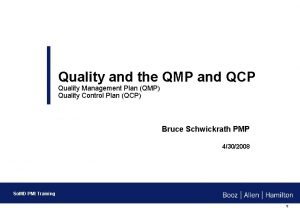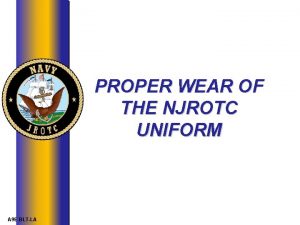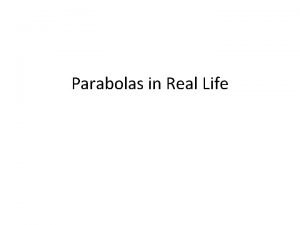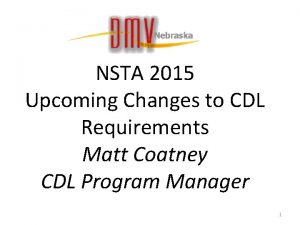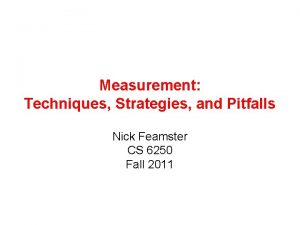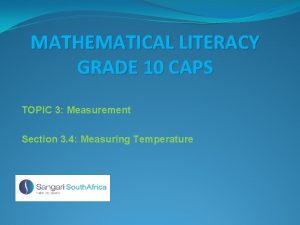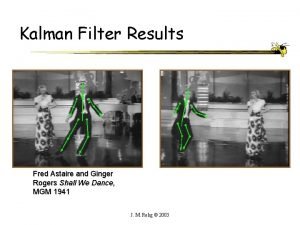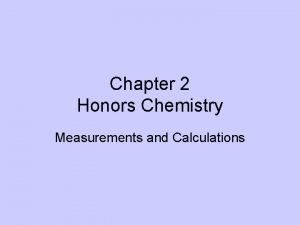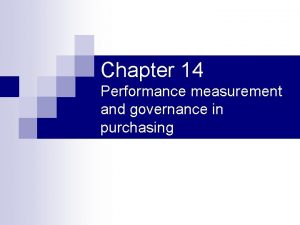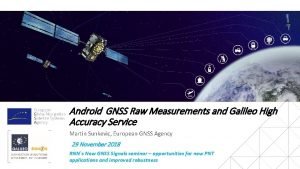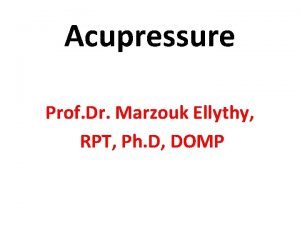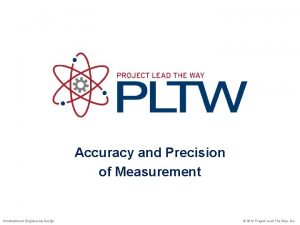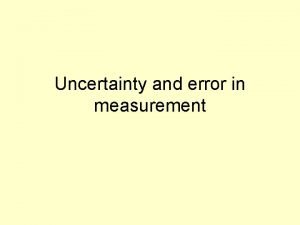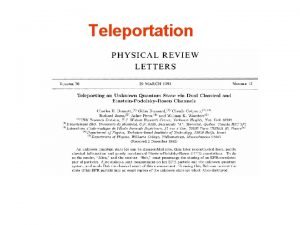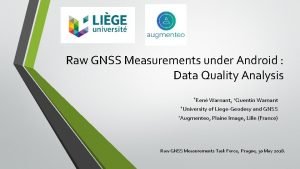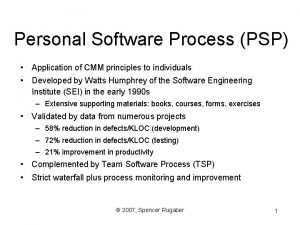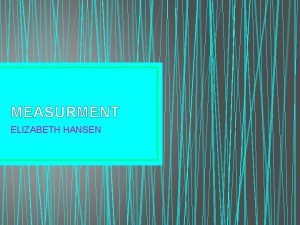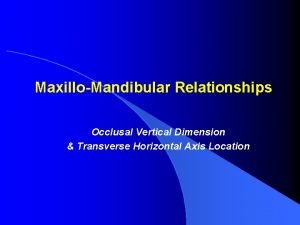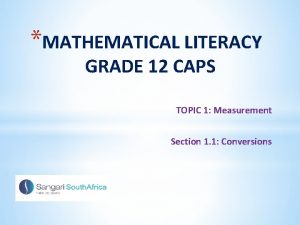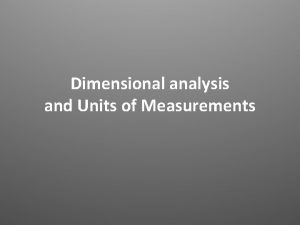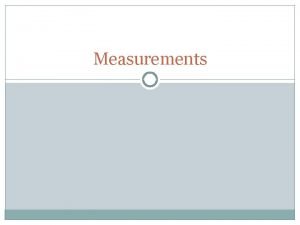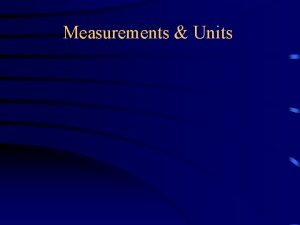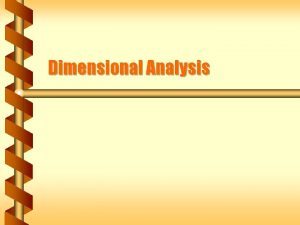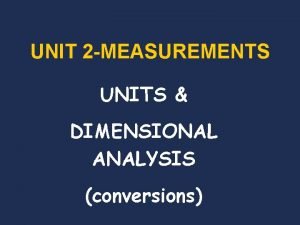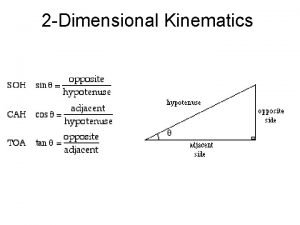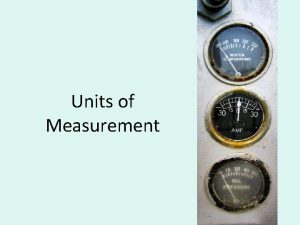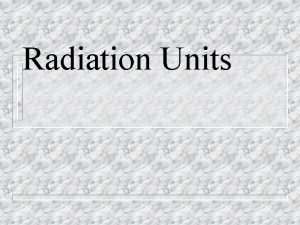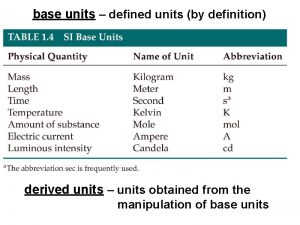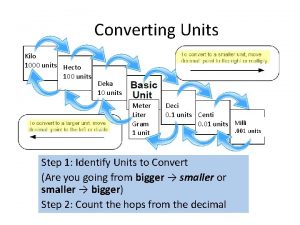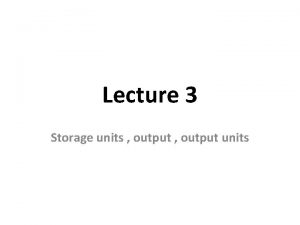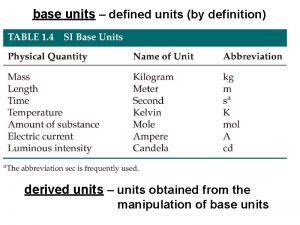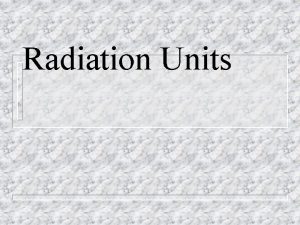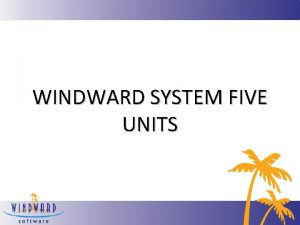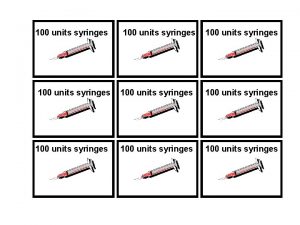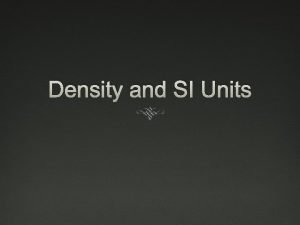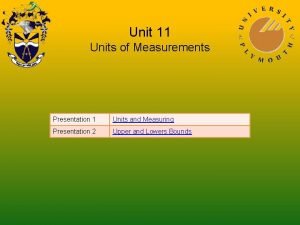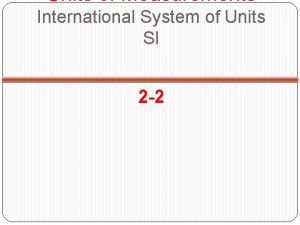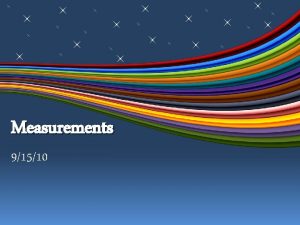Dimensional analysis and Units of Measurements Dimensional analysis




































































- Slides: 68

Dimensional analysis and Units of Measurements

Dimensional analysis • Dimensional analysis uses conversion factors to convert from one unit to another. • Also called Factor Label (and railroad tracks) • You do this in your head all the time – How many quarters are in 4 dollars?

Dimensional analysis practice 3 Big Mac = 7 salads 9 salads = 2 slices of pepperoni pizza 22 slices of pepperoni pizza = 27 Sonic cokes Ex. 1) What number of Big Macs equal 365. 4 salads? Ex. 2) How many sonic cokes do you have to drink to equal 11 salads?

Units of Measurement Meter m Liter L Celsius C

Mass is the amount of matter, weight is a measure of the gravitational pull on matter

Prefix Symbol Mega SI Units Scientific notation Factor M 1 x 106 1, 000 Kilo k 1 x 103 1, 000 kilometer (km) Hecto h 1 x 102 100 hectoliter (h. L) Deka da or (D) 1 x 101 10 dekagram (Dg) 1 x 100 1 meter BASE UNIT Example megagram (Mg) Deci d 1 x 10 -1 . 1 deciliter (d. L) Centi c 1 x 10 -2 . 01 centimeter (cm) Milli m 1 x 10 -3 . 001 milligram (mg) Micro u 1 x 10 -6 . 000001 microgram (ug) Nano n 1 x 10 -9 . 00001 nanometer (nm) Pico p 1 x 10 -12 . 0000001 picogram (pg)

Practice In each pair below, circle the larger Millimeter Centimeter picometer Micrometer kilogram Hectogram deciliter millileter

Practice In each pair below, circle the larger Millimeter Centimeter picometer Micrometer kilogram Hectogram deciliter millileter

Practice In each pair below, circle the larger Millimeter Centimeter picometer Micrometer kilogram Hectogram deciliter millileter

Practice In each pair below, circle the larger Millimeter Centimeter picometer Micrometer kilogram Hectogram deciliter millileter

Practice In each pair below, circle the larger Millimeter Centimeter picometer Micrometer kilogram Hectogram deciliter millileter

Basic SI Units Quantity Length Mass Time Volume Temperature Amount of substance Heat & Energy Base unit meter (m) gram (g) second (s) Liter (L) Kelvin (K) or Celsius (C) mole (mol) joule (J)

Metric Conversions Practice Ex. 3) 2. 435 g _________cg Ex. 4) 23. 8 m. L = ________k. L Ex. 5) 23. 5 cs = ________ns

Some Useful Conversions Length: 1 in = 2. 54 cm 1 mi = 5280 ft Volume: 1 cm 3 = 1 m. L 1 L = 1. 06 qt Weight: 1 kg = 2. 2 lb 16 oz = 1 lb 1 ton = 2000 lb


Temperature Use both the Kelvin and Celsius scale, to convert Celsius + 273 = Kelvin -273 = Celsius • 20°C = K

Temperature Use both the Kelvin and Celsius scale, to convert Celsius + 273 = Kelvin -273 = Celsius • 20°C = 293 K

Temperature Use both the Kelvin and Celsius scale, to convert Celsius + 273 = Kelvin -273 = Celsius • 20°C = 293 K • 373 K = °C

Temperature Use both the Kelvin and Celsius scale, to convert Celsius + 273 = Kelvin -273 = Celsius • 20°C = 293 K • 373 K = 100 °C

Volume: measured in cubic centimeters (cm ) or liters 3 • 1 liter (L) = 1 cubic decimeter (dm 3) = 1000 millileters (m. L) • 1 m. L= 1 cm 3

• Volume can be measure by Length x x or the Water Displacement method

• Volume can be measure by Length x width x or the Water Displacement method

• Volume can be measure by Length x width x height or the Water Displacement method

• Volume can be measure by Length x width x height or the Water Displacement method Know the relationship between the following volume units… L = m. L = cm 3 (or cc in medical lingo)

• Volume can be measure by Length x width x height or the Water Displacement method Know the relationship between the following volume units… 1 L = m. L = cm 3 (or cc in medical lingo)

• Volume can be measure by Length x width x height or the Water Displacement method Know the relationship between the following volume units… 1 L = 1000 m. L = cm 3 (or cc in medical lingo)

• Volume can be measure by Length x width x height or the Water Displacement method Know the relationship between the following volume units… 1 L = 1000 m. L = 1000 cm 3 (or cc in medical lingo)

Density • Is the ratio of mass per unit of volume. How much matter is packed into a given amount of space • Density = mass/volume • D= m/v

• The Density of a substance stays regardless of the size of the sample. For example: if you cut a block of copper in half, you have decreased both the mass and volume, the ratio of the 2 stays the same. This is called an Intensive Physical Property.

• The Density of a substance stays constant regardless of the size of the sample. For example: if you cut a block of copper in half, you have decreased both the mass and volume, the ratio of the 2 stays the same. This is called an Intensive Physical Property.

• The appropriate units of density are: • for solids • for liquids

• The appropriate units of density are: • g/cm 3 for solids • for liquids

• The appropriate units of density are: • g/cm 3 for solids • g/m. L for liquids

Example problems: • A sample of aluminum metal has a mass of 8. 4 g. The volume of the sample is 3. 1 cm 3. Calculate the Density of aluminum.

Example problems: • A sample of aluminum metal has a mass of 8. 4 g. The volume of the sample is 3. 1 cm 3. Calculate the Density of aluminum. • 8. 4 g/3. 1 cm 3 =

Example problems: • A sample of aluminum metal has a mass of 8. 4 g. The volume of the sample is 3. 1 cm 3. Calculate the Density of aluminum. • 8. 4 g/3. 1 cm 3 = 2. 7 g/cm 3

Example problems: • Diamond has a density of 3. 26 g/cm 3. What is the mass of a diamond that has a volume of 0. 350 cm 3?

Example problems: • Diamond has a density of 3. 26 g/cm 3. What is the mass of a diamond that has a volume of 0. 350 cm 3? • 3. 26 g/cm 3 x 0. 350 cm 3 =

Example problems: • Diamond has a density of 3. 26 g/cm 3. What is the mass of a diamond that has a volume of 0. 350 cm 3? • 3. 26 g/cm 3 x 0. 350 cm 3 = 1. 14 g

Example problems: • What is the volume of a sample of liquid mercury that has a mass of 76. 2 g, given that the density of mercury is 13. 6 g/m. L?

Example problems: • What is the volume of a sample of liquid mercury that has a mass of 76. 2 g, given that the density of mercury is 13. 6 g/m. L? 76. 2 g = 13. 6 g/m. L

Example problems: • What is the volume of a sample of liquid mercury that has a mass of 76. 2 g, given that the density of mercury is 13. 6 g/m. L? 76. 2 g = 5. 60 m. L 13. 6 g/m. L

Reliable Measurements • refers to the closeness of the measure value is to the , or real, value. • refers to how a series of measurements are to one another.

Reliable Measurements • Accuracy refers to the closeness of the measure value is to the , or real, value. • refers to how a series of measurements are to one another.

Reliable Measurements • Accuracy refers to the closeness of the measure value is to the accepted, or real, value. • refers to how a series of measurements are to one another.

Reliable Measurements • Accuracy refers to the closeness of the measure value is to the accepted, or real, value. • Precision refers to how a series of measurements are to one another.

Reliable Measurements • Accuracy refers to the closeness of the measure value is to the accepted, or real, value. • Precision refers to how close a series of measurements are to one another.


• is calculated by subtracting the value from the value.

• Error is calculated by subtracting the experimental value from the accepted value.

• The is the ratio of an error to an accepted value.

• The percent error is the ratio of an error to an accepted value.

% error = error x 100 = accepted value – experimental value x 100 accepted value

Example • An experiment finds the density of lead to be 10. 95 g/cm 3. The literature value for the density of lead is 13. 34 g/cm 3.

An experiment finds the density of lead to be 10. 95 g/cm 3. The literature value for the density of lead is 13. 34 g/cm 3. The error: accepted value – experimental value= • 13. 34 – 10. 95 =

An experiment finds the density of lead to be 10. 95 g/cm 3. The literature value for the density of lead is 13. 34 g/cm 3. The error: accepted value – experimental value= • 13. 34 – 10. 95 = 2. 39

The error: accepted value – experimental value= • 13. 34 – 10. 95 = 2. 39 The % error: error x 100 = accepted value 2. 39 x 100 = 13. 34

The error: accepted value – experimental value= • 13. 34 – 10. 95 = 2. 39 The % error: error x 100 = accepted value 2. 39 x 100 = 17. 9% 13. 34

Practice • Sara’s lab shows the atomic mass of aluminum to be 28. 9. What is her percent error if the accepted value is 27. 0?

Practice • Sara’s lab shows the atomic mass of aluminum to be 28. 9. What is her percent error if the accepted value is 27. 0? • 28. 9 – 27. 0 =

Practice • Sara’s lab shows the atomic mass of aluminum to be 28. 9. What is her percent error if the accepted value is 27. 0? • 28. 9 – 27. 0 = 1. 90

Practice • Sara’s lab shows the atomic mass of aluminum to be 28. 9. What is her percent error if the accepted value is 27. 0? • 28. 9 – 27. 0 = 1. 90 • 1. 90/27. 0 x 100% =

Practice • Sara’s lab shows the atomic mass of aluminum to be 28. 9. What is her percent error if the accepted value is 27. 0? • 28. 9 – 27. 0 = 1. 90 • 1. 90/27. 0 x 100% = 7. 04%

Practice • What is the percent error in a measurement of the boiling point of bromine if the textbook value is 60. 8 °C and the lab value is 40. 6 °C?

Practice • What is the percent error in a measurement of the boiling point of bromine if the textbook value is 60. 8 °C and the lab value is 40. 6 °C? • 60. 8 °C – 40. 6 °C =

Practice • What is the percent error in a measurement of the boiling point of bromine if the textbook value is 60. 8 °C and the lab value is 40. 6 °C? • 60. 8 °C – 40. 6 °C = 20. 2 °C

Practice • What is the percent error in a measurement of the boiling point of bromine if the textbook value is 60. 8 °C and the lab value is 40. 6 °C? • 60. 8 °C – 40. 6 °C = 20. 2 °C • 20. 2 °C / 60. 8 °C x 100% =

Practice • What is the percent error in a measurement of the boiling point of bromine if the textbook value is 60. 8 °C and the lab value is 40. 6 °C? • 60. 8 °C – 40. 6 °C = 20. 2 °C • 20. 2 °C / 60. 8 °C x 100% = 33. 2%
 Physical quantity
Physical quantity Units of linear measurement
Units of linear measurement A circular motion is one dimensional
A circular motion is one dimensional Bocouture doses
Bocouture doses When units manufactured exceed units sold:
When units manufactured exceed units sold: Measurements system analysis
Measurements system analysis Measure phase steps
Measure phase steps Measurements equivalents and adjustments
Measurements equivalents and adjustments Chapter 2 measurements and calculations
Chapter 2 measurements and calculations Force and torque measurements
Force and torque measurements Ee8403 measurements and instrumentation
Ee8403 measurements and instrumentation Vital signs and anthropometric measurements
Vital signs and anthropometric measurements Chapter 36 body measurements and vital signs
Chapter 36 body measurements and vital signs Segment lengths intersecting chords secants and tangents
Segment lengths intersecting chords secants and tangents Vital signs normal values
Vital signs normal values Dr lucy jennifer
Dr lucy jennifer Measurements and uncertainties ib physics
Measurements and uncertainties ib physics Measurements and their uncertainty answer key
Measurements and their uncertainty answer key Pharmaceutical measurements
Pharmaceutical measurements Diamtral
Diamtral Metrology and measurements subject code
Metrology and measurements subject code What is tablespoon abbreviation
What is tablespoon abbreviation Measurements and calculations chapter 2 test
Measurements and calculations chapter 2 test Pharmacy measurements
Pharmacy measurements Using and expressing measurements
Using and expressing measurements Measurements and scientific tools lesson 2
Measurements and scientific tools lesson 2 Weights and measure training
Weights and measure training The household system
The household system Instrumentation and measurements
Instrumentation and measurements Instrumentation and measurements
Instrumentation and measurements Gdp types
Gdp types Using and expressing measurements
Using and expressing measurements Dimensional similitude
Dimensional similitude Dimensional analysis and its applications
Dimensional analysis and its applications Dimensional analysis with scientific notation
Dimensional analysis with scientific notation Dimensional analysis worksheet chemistry
Dimensional analysis worksheet chemistry 2-7 literal equations and dimensional analysis
2-7 literal equations and dimensional analysis Scientific notation and dimensional analysis
Scientific notation and dimensional analysis A cart travels with a constant nonzero acceleration
A cart travels with a constant nonzero acceleration What diagram shows surface weather measurements
What diagram shows surface weather measurements Genesis 6 16
Genesis 6 16 Significant figures definition
Significant figures definition How many sig figs in 150
How many sig figs in 150 It consists of numbers representing counts or measurements
It consists of numbers representing counts or measurements Si unit in science
Si unit in science Ankle rom
Ankle rom What is qmp
What is qmp Njrotc uniform measurements
Njrotc uniform measurements Mitral stenosis echo guidelines
Mitral stenosis echo guidelines Posterior palatal seal
Posterior palatal seal Parabolas in life
Parabolas in life Cdl parallel parking dimensions
Cdl parallel parking dimensions Cs6250 bgp measurements
Cs6250 bgp measurements Mathematical literacy grade 10 measurements
Mathematical literacy grade 10 measurements Long jump measurement
Long jump measurement Ginger rogers measurements
Ginger rogers measurements Measurements in chemistry
Measurements in chemistry Purchasing goals measurements
Purchasing goals measurements Pnt
Pnt Cun measurements tcm
Cun measurements tcm Precise measurements are always accurate
Precise measurements are always accurate Random errors may be detected by repeating the measurements
Random errors may be detected by repeating the measurements Bell measurements for teleportation
Bell measurements for teleportation Dr katherine kuhlman measurements
Dr katherine kuhlman measurements Android force full gnss measurements
Android force full gnss measurements Psp emphasize personal measurements of
Psp emphasize personal measurements of What was the significance of the metric act of 1866?
What was the significance of the metric act of 1866? Mandibular wax rim dimensions
Mandibular wax rim dimensions Mathematical literacy conversion table
Mathematical literacy conversion table

